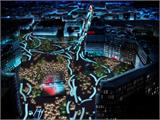Architecture, the composition of the future sky - Technical Information - Design Group Network
When skyscrapers tear the sky into pieces, facing the constantly reinforced fragmentation that has almost become the mainstream action of architectural aesthetics for a century, Japanese architect Kengo Kuma attempts to remind us with his own strength that the starting point of architecture is not fragmentation but rather to allow individuals and lives to be better connected to the world through buildings.
Reading Kengo Kuma's "Anti-Form," one first feels his near-obsessive contemplation, reflection, and anxiety about architecture and design throughout the book. Kuma never seems to think highly of his own designs; instead, he is filled with concern for the fields of architecture and design and strives to interpret, alleviate, and change these concerns through his works, offering people another perspective.
Question: What kind of architectural form can emerge without deliberately pursuing symbolic meaning or visual needs?
In the preface to another of his books, "Negative Architecture," Kuma despairingly discusses the Hanshin earthquake, the Aum Shinrikyo terrorist attacks, and 9/11. In light of these events, humanity's grandest and most substantial product—architecture—has repeatedly shattered the myth of reliability, exposing its inherent fragility. Kuma persistently questions how it is possible to abandon the motivation to build so-called stable structures?; what kind of architectural form could emerge without deliberately pursuing symbolic meaning, visual needs, or satisfying the desire to possess? If "Negative Architecture" expresses Kuma's doubts and concerns about the stability and permanence of architecture itself, then the newly released "Anti-Form" reconsiders and reviews the history of modern architecture from the perspectives of columns, pedestals, fragmentation, prominence, and image-dominated architectural experiences and dissemination methods, attempting to break the monopoly of formalist architecture.
I would call Kengo Kuma an architectural philosopher. In his books, we rarely read about exquisitely detailed architectural techniques but rather find his thoughts extending into various disciplines such as philosophy, economics, literature, art, and physics. Precious is the fact that he has forged his own architectural ontology. Facing his grand selection, piecing together, and hanging of various intellectual materials, I was momentarily lost in thought, wondering if Kuma also intends to construct his own intellectual architecture within the pages of books.



